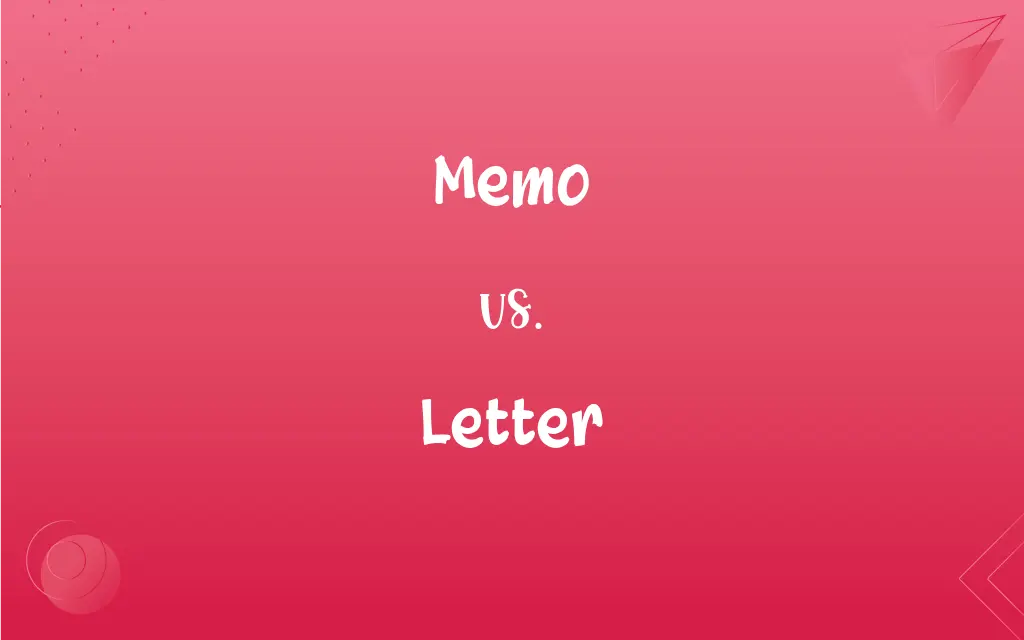Memo vs. Letter: What's the Difference?
Edited by Aimie Carlson || By Harlon Moss || Updated on October 2, 2023
A memo is a brief, formal communication within an organization, while a letter is a written message addressed to external parties or individuals.

Key Differences
A memo, short for memorandum, is typically used for communication within an organization or a particular department. It is often brief and direct, focusing on sharing information, instructions, or requests internally, ensuring that staff members are aligned with specific data or directives. In contrast, a letter is a comprehensive communication tool used to converse with external entities or individuals, enveloping various purposes from informational to expressive, and can be more detailed and personalized.
The memo generally utilizes a succinct and straightforward language style, aiming to convey its message with clarity and brevity, which can be crucial for internal coordination and communication. On the other hand, a letter may embody a more elaborate and cordial language style, providing detailed information, expressing sentiments, or elaborating on particular topics, catering to a potentially broader and varied audience, including clients, customers, or personal acquaintances.
Formatting often marks a noticeable difference between a memo and a letter. Memos tend to have a standard format that includes headings such as “To,” “From,” “Date,” and “Subject,” presenting key information at the onset. In comparison, letters generally open with a salutation and close with a valediction, often being more formal and adhering to etiquette, and can incorporate various formats depending on the purpose and recipient.
The distribution method can also differentiate a memo from a letter. Memos are commonly distributed electronically or via internal communication channels within an organization, ensuring rapid and wide dissemination of information among staff. Alternatively, letters may be sent via postal mail, email, or hand-delivered, depending on the context and recipient, and typically signify a more personal or formal mode of communication.
Usage context further accentuates the distinction between memos and letters. While memos often serve to inform, update, or request actions from internal members, maintaining an intradepartmental or intraorganizational scope, letters usually traverse organizational boundaries, serving purposes such as business inquiries, personal communication, or official notifications, thereby navigating through varied contextual frameworks.
ADVERTISEMENT
Comparison Chart
Purpose
Internal communication
External or personal communication
Language Style
Direct and succinct
Can be detailed and expressive
Format
Standardized headings
Includes salutations and valedictions
Distribution Method
Often electronically within an organization
Via postal mail, email, or hand delivery
Context
Typically intraorganizational
Can be interpersonal or interorganizational
ADVERTISEMENT
Memo and Letter Definitions
Memo
An internal message to convey instructions.
A memo was circulated to inform staff about the upcoming audit.
Letter
A method of formal communication between entities.
The company sent a letter of appreciation to its partner.
Memo
A written reminder or update for internal stakeholders.
The weekly memo updated the team about the project’s progress.
Letter
A written communication sent to an external party.
She sent a letter to the supplier regarding the delayed shipment.
Memo
A note to assist the memory.
She wrote a quick memo to remind herself of the meeting.
Letter
A formatted, polite correspondence with salutations.
The letter to the client started with a warm greeting.
Memo
A documented notice for internal policy changes.
The memo highlighted the amendments in the leave policy.
Letter
A written document to express information or emotions.
The apology letter was filled with remorseful expressions.
Memo
A brief written communication within an organization.
The manager issued a memo regarding the new working hours.
Letter
A composed message for personal correspondence.
He received a heartfelt letter from his grandmother.
Memo
A memorandum.
Letter
A written symbol or character representing a speech sound and being a component of an alphabet.
Memo
A short note; a memorandum.
Letter
A written symbol or character used in the graphemic representation of a word, such as the h in Thames. See Note at Thames.
Memo
(programming) A record of partial results that can be reused later without recomputation.
Letter
Often letters A certified document granting rights to its bearer.
Memo
(informal) To record something; to make a note of something.
Letter
Literal meaning
Had to adhere to the letter of the law.
Memo
(informal) To send someone a note about something, for the record.
I made sure to memo him about the client's complaints.
Memo
A written proposal or reminder
FAQs
What is a memo primarily used for?
A memo is used for internal communication within an organization, typically to inform or instruct staff.
Can a letter serve as a legal document?
Yes, letters can serve as legal documents, especially in matters like agreements or official notifications.
What is the general purpose of a letter?
A letter is used for communication outside the organization or for personal correspondence, and can serve various purposes.
How does the format of a memo typically look?
Memos often have a straightforward format with headings like "To," "From," "Date," and "Subject."
Are memos becoming obsolete with digital platforms emerging?
While digital platforms are popular, memos remain a staple for formalized internal communication in many organizations.
How is the format of a letter typically structured?
Letters usually start with a salutation, contain a body of text, and end with a valediction and signature.
How is a memo typically distributed within a company?
Memos are often distributed electronically via email or internal communication platforms.
Can a letter be used for internal communication?
Yes, letters can be used internally, but memos are more standard for intraorganizational messages.
What type of language is typically used in a memo?
Memos usually employ direct and succinct language, aiming for clear and efficient communication.
What tone is usually adopted in a letter?
Letters may adopt various tones, such as formal, friendly, or cordial, depending on the recipient and purpose.
Is letter writing still prevalent in the digital age?
While digital communication is dominant, letter writing persists for formal correspondence and personal communication.
Can memos and letters be used interchangeably?
While both are communication tools, their contexts and formats are different and are generally not used interchangeably.
When writing a letter, what elements are crucial?
When writing a letter, ensure it has a clear purpose, appropriate tone, and follows the conventional format of salutation and valediction.
Is a memo usually more brief than a letter?
Yes, memos are typically briefer and more direct than letters, which may be more detailed and expressive.
How are letters typically sent?
Letters can be sent via postal mail, email, or hand-delivered, depending on the context and recipient.
Can a memo serve as a legal document?
While not common, memos can serve as a record of communication or decisions within an organization.
What should be avoided in writing a memo?
Avoid being too verbose, informal, or unclear when writing a memo to maintain its efficacy.
Can a memo be used for external communication?
Though not common, memos can be used externally, usually in a business-to-business context.
Is it necessary to keep records of memos in a company?
Keeping records of memos is often advisable to track internal communication and decisions.
Why might someone choose to send a letter instead of an email?
A letter may be chosen over email for a more personal touch, formal correspondence, or if physical documentation is needed.
About Author
Written by
Harlon MossHarlon is a seasoned quality moderator and accomplished content writer for Difference Wiki. An alumnus of the prestigious University of California, he earned his degree in Computer Science. Leveraging his academic background, Harlon brings a meticulous and informed perspective to his work, ensuring content accuracy and excellence.
Edited by
Aimie CarlsonAimie Carlson, holding a master's degree in English literature, is a fervent English language enthusiast. She lends her writing talents to Difference Wiki, a prominent website that specializes in comparisons, offering readers insightful analyses that both captivate and inform.































































